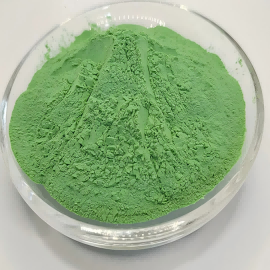Phosphorus chemicals
Nickel Oxide
- CAS: 1313-99-1
Name:Nickel Oxide
Molecular formula:NiO
Molecular Weight:74.70
CAS:1313-99-1 / 1314-06-3
Characteristics:
Nickel monoxide is green powder,or yellow powder when overheated.The specific weight of it is 6.6-6.8 and melting point 1990℃.It dissovlves in sulfuric acid,nitric acid,hydrochloric acid and ammonia solution while insoluble in water and liquid ammonia.When heated to 400℃ in air it is oxidized to nichel troxide,however,it is deoxidized back to nickel monoxide wehn heated to 600℃.The nickel monoxide made through a process of being calcined at low temperature is chemical activated,in contrast to being calcined at 1000℃,it is green yellow and lower chemical activity:That is ,the higher calcination temperature of manufacutring process,the higher density and resistance as well as the lower solubility and catalytic activity of nickel monoxide.
Basic information:
Ni:78% Min
Co:0.03% Max
Cu:0.02% Max
Fe:0.02% Max
Zn:0.005% Max
S:0.005% Max
Ca:0.03% Max
Mg:0.03% Max
Na:0.02% Max
Hydrochloric acid,insoluble substances:0.10% Max.
Size: through 500 mesh sieve,sieve residue of not more than 0.5%.
Primary applications:
1. Ceramics and Glass Industry (as a Colorant)
This is one of the largest and most traditional applications for nickel oxide CAS:1313-99-1 / 1314-06-3.
Coloring Agent: Nickel oxide is used to impart colors to glass, glazes, and ceramics.
Glass: It can produce a range of colors frombrowns and purples toblues and grays, depending on the composition of the glass and the furnace atmosphere.
Ceramics & Frits: It is famously used to create"nickel black" and various shades ofgreen and blue in ceramic glazes and porcelain enamels.
Decolorizer: Ironically, in very small quantities, it can also be used to neutralize unwanted green tints in glass caused by iron impurities.
2. Electronics and Functional Materials
Nickel oxide's functional properties make it valuable in advanced technologies.
Varistors: It is a key dopant in zinc oxide (ZnO) based varistors. These are electronic components whose resistance changes dramatically with voltage, and they are essential forsurge protection in electrical and electronic systems (e.g., power strips, lightning arresters).
Thermistors: As a negative temperature coefficient (NTC) thermistor material, its resistance decreases predictably with temperature. This makes it useful intemperature sensors and compensation circuits.
Electrochromic Devices: Thin films of nickel oxide can change their optical properties (e.g., from transparent to dark) when a small electrical voltage is applied. This is used in:
Smart Windows for dynamic control of light and heat in buildings.
Anti-glare rearview mirrors in automobiles.
Semiconductor: As a p-type semiconductor, it is being researched for use in transparent electronics, photodetectors, and as a hole-transport layer in various optoelectronic devices.
3. Chemical and Process Industry (as a Catalyst)
Nickel oxide serves as a catalyst or a catalyst precursor in several chemical reactions.
Hydrogenation Reactions: It is used to catalyze the addition of hydrogen to organic compounds.
Oxidation Reactions: It acts as a catalyst in the oxidation of organic chemicals.
Methane Reforming: While metallic nickel is the active catalyst, nickel oxide is often the initial material used in catalysts for steam reforming of methane to produce hydrogen and syngas. The oxide is reduced to the active metal form under process conditions.
Fischer-Tropsch Process: It can be part of catalysts used to convert syngas (CO + H₂) into liquid hydrocarbons.
4. Energy Storage (Batteries)
Nickel-Based Batteries: Nickel oxide is a fundamental raw material for the production of the positive electrode (cathode) in several types of rechargeable batteries.
Nickel-Iron (Ni-Fe) Batteries: A classic, robust battery technology.
Nickel-Cadmium (Ni-Cd) Batteries: A mature technology, though its use is declining due to environmental concerns about cadmium.
Nickel-Metal Hydride (Ni-MH) Batteries: Widely used in consumer electronics (like early laptops and cameras) and hybrid electric vehicles (like the Toyota Prius).
5. Foundry and Metallurgy
Alloy Production: Nickel oxide can be used as a source of nickel in the production of nickel-containing alloys, such as stainless steel and superalloys. It is often reduced by carbon in the furnace to yield metallic nickel, which dissolves into the melt.
Bonding Agent: In powder metallurgy, it can act as a bonding agent.
6. Other Niche Applications
Ferrite Production: It is a component in the manufacture of soft magnetic ferrites, which are used in inductors, transformers, and electromagnetic cores.
Fuel Cell Research: It is investigated as a potential material for electrodes in certain types of fuel cells.
Package : 25kg kraft bag or paper drum.
Categories
News
Contact Us
Contact: Hxochemical
Phone: +86-512-36622455 +86 13285168509+86 13330004268(WhatsApp)
Tel: +86-512-36622455
E-mail: sales@hxochem.com support@hxochem.com logistic@hxochem.com
Add: No. 1377, Fuchunjiang Road, Kunshan Development Zone, Jiangsu Province, China




